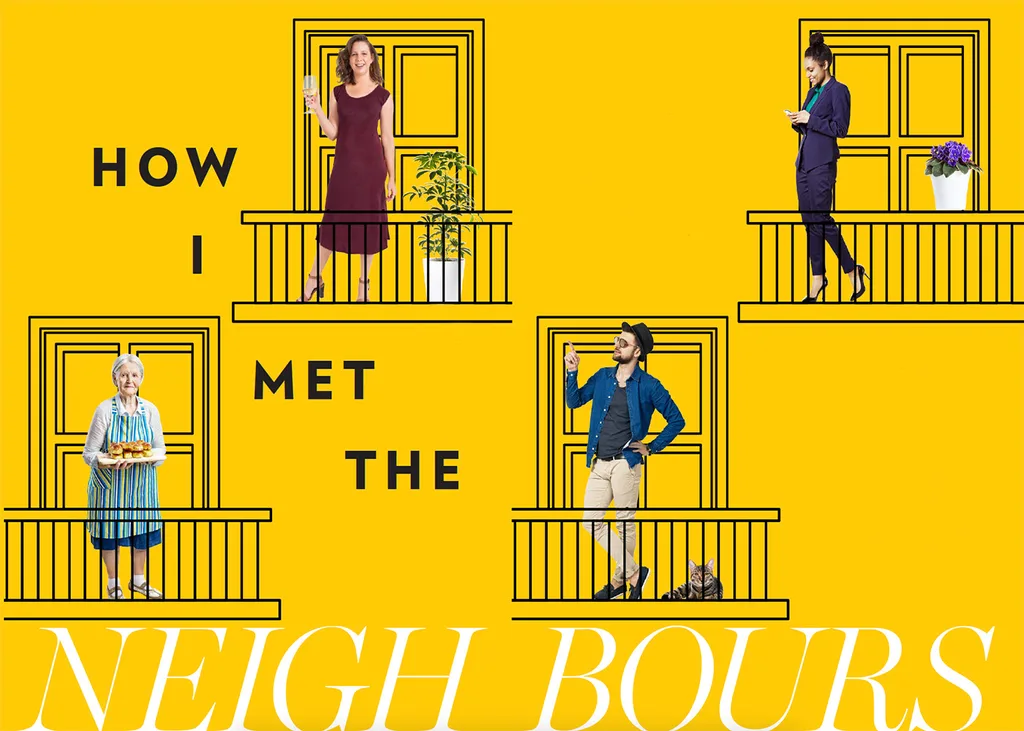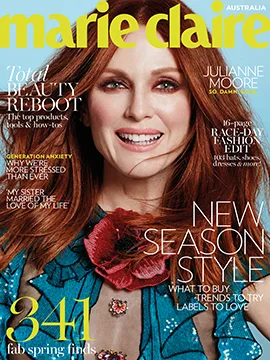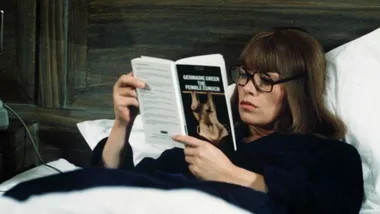Thirty years ago, the majority of Australians were on a first-name basis with their neighbours. Today? Not so much. Alley Pascoe bakes some metaphorical muffins and sets out to meet the people who share her street.

It’s a Tuesday night and I’m sitting on the kitchen floor of Michelle’s house playing with her nine-month-old son Ardon while she cooks salmon pasta for dinner. As Ardon grabs at the tassels on my scarf, we chat about her maternity leave, the dog park across the road and how she copes when her husband is away for work. But Michelle isn’t a friend or relative. She’s a complete stranger, who I met just minutes earlier when I nervously knocked on her door and she answered with an apron around her waist and a baby on her hip.
Approaching randoms in their own homes is not something I do every day. It’s part of an experiment I’m conducting for marie claire, to find out how to connect with your neighbours. It’s something that, I admit until very recently, I hadn’t done at all.
Today I’m road-testing Food St, a website that connects home cooks with hungry people – i.e. me – in their area. Tonight, Michelle is cooking dinner for my boyfriend and me to take home. It’s one of many attempts I’ve made to meet my neighbours in the past month, with varying degrees of success.
It started with an unsettling realisation. I’ve lived in my small apartment block in Mosman, on Sydney’s lower north shore, for a year, but I don’t know any of my neighbours. None. A woman not much older than me lives next door. We leave for work at the same time each morning, walk a discreet 10 paces behind each other and proceed to avoid eye contact at the ferry wharf. The only interaction I’ve had with anyone else in the building was when my boyfriend accidentally watered my downstairs neighbour’s drying laundry along with the plants sitting on our balcony. Does swearing count as an interaction?
Turns out I’m anything but an outlier. A recent survey by Jigsaw Research found only half of us would recognise our own neighbour on the street. More than that, less than 8 per cent of us are friends with our neighbours on Facebook. Social researcher and psychologist Hugh Mackay says not knowing our neighbours has become a cliché of contemporary urban life and it doesn’t come without cost, including our sense of wellbeing, level of anxiety and even our physical health. “Feeling like a stranger in your own street is bound to fuel your insecurities, because we’re less inclined to trust our neighbours,” he says. “This declining sense of trust makes us feel more socially isolated – and we can’t survive in isolation.”
Determined to end the isolation, I started my quest for community spirit the traditional way – by making small talk in the lift. One night after work, instead of furiously pressing the closedoor button at the sound of approaching footsteps, I hold the lift for my upstairs neighbour and strike up a conversation as the doors close. Our observations on the weather are cut short when I get off on the second floor. It’s there that my (sixth floor) neighbour must realise that I’m not just overly chatty, but also lazy.
Next, I consider knocking on my neighbour’s door to borrow a cup of sugar, but then I remember everyone in my suburb gave up sugar in 2015. Why in Australia – a country whose longest-running TV drama is called Neighbours – is it so hard to meet our neighbours? Mackay chalks it up to changes in society. Nowadays we move more often, live in smaller households, turn to our phones for company and complain about how busy we are on Facebook. “We’ve become .a more individualistic society,” he explains. “We think more about ourselves than our neighbourhood and the community.”
Sadly, the Journal of Clinical Nursing says a third of Australians feels lonely at any given time. But it wasn’t always like this. In the mid 1980s, the average Australian knew 7.1 people in their local area who they could ask for small favours. In the mid 2000s, that number dropped to 5.7.
When I locked myself out a few months ago, I didn’t have anyone close by to ask for help. I sat in the park across the road sending angry “hurry up” text messages to my boyfriend.

I grew up in the 1990s in Bellingen, a small country town on the NSW mid-north coast, and knew all my neighbours, their parents and guinea pigs. According to Mackay, these close neighbourhood relationships are important for our human biology and our moral development. “We are social creatures, we need each other. Communities give us personal identity,” he says. Growing up with a strong sense of community made me who I am: a confident, down-to-earth bogan.
Concerned for my personal identity in 2017, my next move is to join the Mosman Community Gardeners club. Wearing my $1.20 Bunnings gloves, a lovely lady called Cynthia gives me a guided tour of the worm farms. I then follow Sally, who lives on my street, to plant a crop of potatoes with Renata and her daughter Georgia. Like me, Renata joined the community garden to connect with her neighbours. “We used to live in Shanghai and there isn’t a sense of community there. When we moved back to Sydney, I wanted my kids to have that,” she says.
After an hour of hard yakka (read: watering plants), the club sits down for afternoon nibbles and tea. I brought wine – naturally – and share it with an astronomer who lives around the corner from me. Despite most of the members being double my age, the conversation flows easily. Laughing with the retirees, I feel a twinge of community spirit.
It makes me wonder if part of my problem is my age. The over-50s seem to have no issue starting chats with anyone. The under-30s, not so much. The statistics say Gen Y is the least connected to their community, with just 15 per cent describing their neighbours as friends, compared with a third of Baby Boomers.
So I did what Millennials do best and downloaded some apps. I started on the Food St website, devouring Michelle’s home cooking. Next, I downloaded Nabo, the neighbourhood social networking app with 250,000 members in 8000 suburbs. When I join, I’m immediately “welcomed” by three of my neighbours, who all live within walking distance from me.
Simon Smith, the CEO of Nabo, says that while the internet can get a bad rap for isolating people, it can also bring them together. Sure, online communities are great, but they’re no substitute for real-life communities. “If you lose your dog, your Facebook friends can sympathise with you, but your neighbours can help,” he analogises.
I organise to meet a few “Nabos” at a local café on Saturday morning. I’m the first to arrive and wait anxiously at a table outside. I haven’t been this nervous since I confessed my undying love to my primary school crush. In my mind, this can go one of two ways. We could all hit it off and become close friends who win the local pub quiz. Or, it could be so painfully awkward that I have to move two suburbs over to avoid running into them again.
When Deborah, a woman in her mid-30s, arrives and it becomes apparent she’s not trying to sell me into a pyramid scheme, I’m instantly relieved. We chat about her work in HR, her three kids and her favourite noodle place. Over the course of two hours, 10 other neighbours come and go for coffee. Sitting across from me is Jeremy the local tennis coach. Judy, a retired teacher, is next to me, and at my feet is Lily, a Cavalier King Charles Spaniel. We make a regular coffee date and I decide I don’t need to move suburbs after all.
Coffee is one thing, but I still haven’t found a neighbour to invite over for wine. And unless you’re “wine friends” with someone, are you really friends? I wonder if I’d have more luck if I still called Bellingen home. My mum, who still lives up the coast, knows all of her neighbours’ names – mostly so she can make noise complaints about them, but still. She walks home from the bowling club on a Friday night with the couple who live next door. “There’s no question it’s harder to connect with people in the city,” says Mackay. “City dwellers are spending more time commuting and working longer hours, so there isn’t much time left for chatting to the neighbours.”
Instead of packing my bags and moving back to my childhood home, I opt for bribery. I post on a Mosman community Facebook page offering a pile of books. Beverley would love to read them and picks them up the next morning. When she knocks on my door, she’s holding a bunch of flowers. She explains that she’s taking a week off after a stressful period at work and is grateful to have something to read. I think about inviting her to share a bottle of wine, but it’s 10am on a Sunday.
There’s only one last nut to crack. The woman who catches my ferry who looks fun and as though she likes a drink. I’d spent the past three mornings awkwardly standing next to her trying to think of something to say, before finally leaning over and saying, “Hi, um, I’m Alley, I live next door.” “I know,” she deadpans. Oh. “I’m Elizabeth, nice to meet you,” she adds, with a smile that nearly makes me weep with relief. We spend the next five minutes chatting. She’s from Italy and has lived in Sydney for two years with her boyfriend. I invite her over for a glass of Italian red wine and feel like a success.
My month has been weird and awkward, but worth it. I genuinely feel safer, happier and like a better person. My neighbourliness has even extended to other areas. Instead of putting my headphones on during a recent flight, I spent the entire 90-minute trip talking to my seat neighbour (hi Dina, from 29E). I may not have found someone to walk me home from the bowling club after a few drinks on a Friday night, but hey, that’s what Uber is for.

 Getty
Getty









